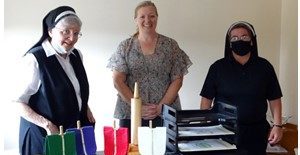Franciscan Sisters of Christian Charity Sister Marsaia Kaster and Sister Veronica Schad are certified catechists participating in the Catechesis of the Good Shepherd program in the Roncalli Elementary School in Manitowoc, Wisconsin.
 The Catechesis of the Good Shepherd does not take place in the classroom. In this approach there are special rooms prepared for the children in what use to be the convent for the parish on Waldo Blvd. Every object in the room is a help to knowing God and is intended to be appropriate to the ages and sizes of the children who gather there. It is a very simple, orderly, and prayerful place called an atrium. Here the child comes in contact with Scripture, the liturgy and in the atrium for the older child, the whole of salvation history.
The Catechesis of the Good Shepherd does not take place in the classroom. In this approach there are special rooms prepared for the children in what use to be the convent for the parish on Waldo Blvd. Every object in the room is a help to knowing God and is intended to be appropriate to the ages and sizes of the children who gather there. It is a very simple, orderly, and prayerful place called an atrium. Here the child comes in contact with Scripture, the liturgy and in the atrium for the older child, the whole of salvation history.
Sister Marsaia shared: “The Good Shepherd and the Child: The Joyful Journey is a beautiful book written by several women who helped to create the Catechesis of the Good Shepherd in the mid-twentieth century, in Italy. These women, influenced by the philosophy and methods of Dr. Maria Montessori, became fascinated with the ‘religious potential’ of children from their earliest years.
“In the book’s forward, Archbishop Marcel A. Gervais from Canada wrote: “The catechesis presented in this book asks us to learn from the children, to be guided by them and to provide for their needs. Parents, teachers, and volunteers are challenged to ‘become as little children.’ The Catechesis of the Good Shepherd is led by the child.”
The approach is not one of teaching as such but of living with the children in the atrium—growing closer to the Lord by offering wondering and pondering questions.
How did they become interested in the Catechesis?
Sister Marsaia: In 2001, a grandnephew was born in our family. Over the next few years I was able to share various moments with him. One day when Nolan was probably three years old: after sharing a picture with him, I asked if he might want to close his eyes and look at Jesus in his heart. After trying, he said “I can’t see Jesus. I want to see Jesus.” For me, that was the beginning. At Christmas I brought him a Nativity set. Together we explored the figures as he asked questions and made remarks. His Mom looked on. (She said I would have to come back more often to answer his questions.) So, it was largely Nolan’s openness and responses that piqued my curiosity. Conversing with Dianne Vadney, the catechist Mom of six children, she had heard of the Catechesis of the Good Shepherd. So, we both began to explo re it; she very actively, and she longed to begin the Catechesis in Manitowoc’s Saint Francis parish ASAP, so that at least some of her own children could benefit first-hand from the experience of the “Joyful” Catechesis.
re it; she very actively, and she longed to begin the Catechesis in Manitowoc’s Saint Francis parish ASAP, so that at least some of her own children could benefit first-hand from the experience of the “Joyful” Catechesis.
Sister Veronica: I heard Dianne and Sister Marsaia talk about the Catechesis of the Good Shepherd, I was skeptical. I didn’t think it would work. After experiencing the children in the atrium setting, I am amazed to see how each child’s spiritual life does grow. The atrium is quiet and the children are reverent. It’s inspiring to see them using the prayer table or how the various works they do makes a difference.
Sister Veronica explained: “In an atrium there are a variety of ‘works’ to develop the religious potential of a child. For example: In the 3-5-year level there are practical life activities—polishing, pouring, transferring and putting away the material they used—to help them prepare for greater works as they move to the next level where they will work to set the altar and pour the wine.
“Other works involve the model altar; liturgical gestures, calendars and colors; parables of the Good Shepherd, mustard seed, and the hidden treasure.
“The story of the leaven that we did earlier this week is one of their favorites. After reading the scripture text and mixing flour, yeast and water together—observing that it has risen in the warmth of the window. They are invited to meditate on the pondering questions: I wonder what Jesus meant? And, how could that tiny bit of yeast make dough get bigger?
‘The adults who take the Catechesis courses for certification feel they learn so much and often say they wish their children would have had this when they were younger. Those who have very young children are excited about the atrium. One four-year-old child asked his mom when he could make his First Communion. (He was truly ready.) Another child told a priest he didn’t hold the epiclesis long enough.”
Sister Veronica also uses some of the atrium materials with her 3rd and 4th graders at St. Gregory in St. Nazianz and in the 2nd grade Faith Formation program in Manitowoc


